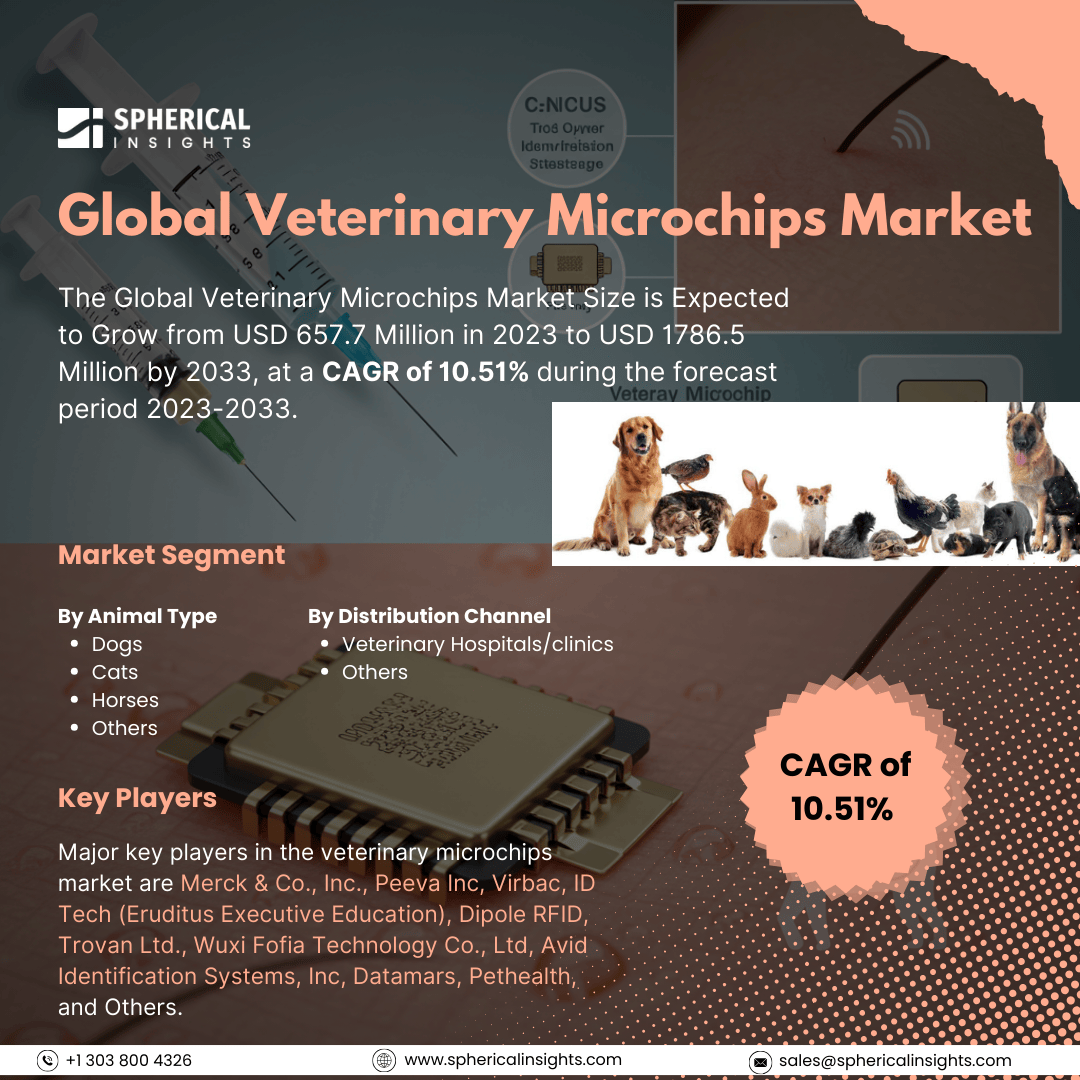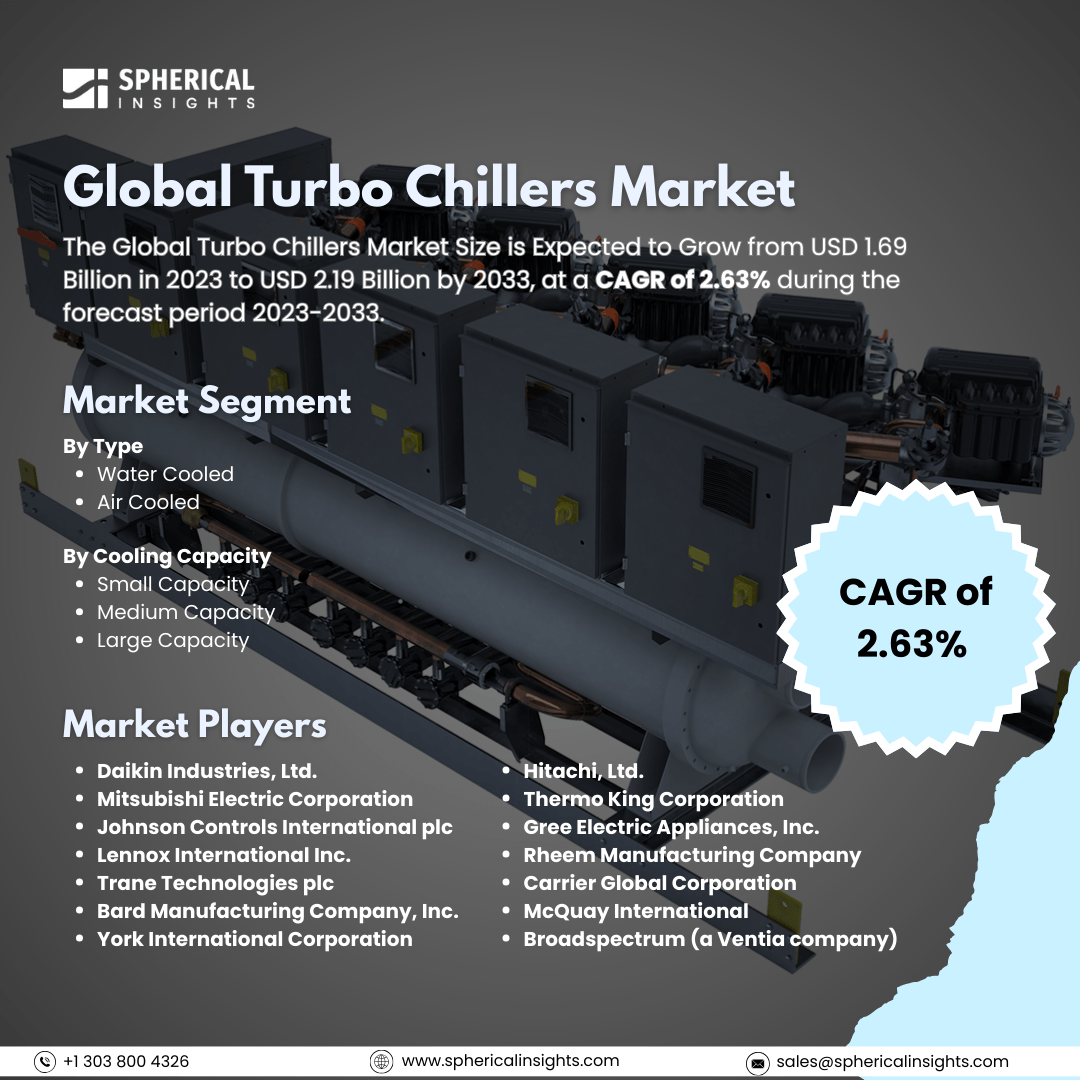Global Veterinary Microchips Market Size to worth USD 1786.5 Million by 2033
According to a research report published by Spherical Insights & Consulting, The Global Veterinary Microchips Market Size is Expected to Grow from USD 657.7 Million in 2023 to USD 1786.5 Million by 2033, at a CAGR of 10.51% during the forecast period 2023-2033.
Browse key industry insights spread across 210 pages with 110 Market data tables and figures & charts from the report on the Global Veterinary Microchips Market Size, Share, and COVID-19 Impact Analysis, By Animal Type (Dogs, Cats, Horses, and Others), By Distribution Channel (Veterinary Hospitals/clinics and Others), and By Region (North America, Europe, Asia-Pacific, Latin America, Middle East, and Africa), Analysis and Forecast 2023 – 2033.
The veterinary microchips market is the development, production, and application of microchip implants for animal identification and tracking. These are small, electronic devices implanted under the skin of animals to store unique identification numbers, enabling accurate tracking, medical record maintenance, and ownership verification. Veterinary microchips are widely used in pets, livestock, and wildlife, and play a vital role in animal healthcare, management, and regulatory compliance. Growth in the market is attributed to the increasing adoption of pet identification systems, awareness of animal welfare, and strict regulations regarding livestock tracking in various regions. Growing pet ownership, along with increasing demand for advanced technologies in animal management, supports market growth. The integration of veterinary microchips with database systems and GPS technology also enhances their functionality and appeal. However, challenges such as the high price of microchip implantation and limited awareness in developing regions may limit market growth.
The dogs segment accounted for the largest share in 2023 and is expected to grow at a significant CAGR during the forecast period.
Based on the animal type, the veterinary microchips market is classified into dogs, cats, horses, and others. Among these, the dogs segment accounted for the largest share in 2023 and is expected to grow at a significant CAGR during the forecast period. The dominance of this segment is attributed to the increasing global dog ownership and the growing emphasis on pet identification for lost and stolen dog recovery. Dogs are often considered family members, prompting pet owners to adopt advanced identification methods like microchipping to ensure their safety and traceability.
The veterinary hospitals/clinics segment accounted for the largest share in 2023 and is expected to grow at a significant CAGR during the forecast period.
Based on the distribution channel, the veterinary microchips market is divided into veterinary hospitals/clinics and others. Among these, the veterinary hospitals/clinics segment accounted for the largest share in 2023 and is expected to grow at a significant CAGR during the forecast period. The dominance of this segment is driven by the trusted role those veterinary hospitals and clinics play in providing comprehensive animal healthcare services, including microchip implantation. Pet owners often rely on veterinary professionals for guidance and services related to animal identification and safety, making hospitals and clinics the primary point of access for microchip adoption.
North America is estimated to hold the largest veterinary microchips market share over the forecast period.
North America is estimated to hold the largest veterinary microchips market share over the forecast period. The primary drivers of the market are well-established competitors and the increasing demand for microchips. Moreover, the industry is growing because of increased per capita income and veterinary treatment costs. The North American Pet Health Insurance Association (NAPHIA) is responsible for regulating the pet insurance industry in this region. 66% of American families, or 86.9 million homes, had a pet in 2023, according to the American Pet Products Association's National Pet Owners Surveys.
Asia-Pacific is predicted to have the fastest CAGR growth in the veterinary microchips market over the forecast period. This is due to the increasing trend of pet adoption and the growth of the local economy. Other factors driving market growth include improved veterinary healthcare infrastructure and heightened awareness of veterinary health. The IMF estimates that by 2024, Asia Pacific's per capita income will have increased from USD 7.35 thousand to USD 10.18 thousand.
Company Profiling
Major key players in the veterinary microchips market are Merck & Co., Inc., Peeva Inc, Virbac, ID Tech (Eruditus Executive Education), Dipole RFID, Trovan Ltd., Wuxi Fofia Technology Co., Ltd, Avid Identification Systems, Inc, Datamars, Pethealth, and Others.
Key Target Audience
- Market Players
- Investors
- End-users
- Government Authorities
- Consulting And Research Firm
- Venture capitalists
- Value-Added Resellers (VARs)
Recent Development
- In May 2023, Datamars bought Kippy S.r.l., the dog's favorite GPS tracker and activity monitoring system, a perfect addition to its already established pet services around the world.
Market Segment
This study forecasts global, regional, and country revenue from 2023 to 2033. Spherical Insights has segmented the veterinary microchips market based on the below-mentioned segments:
Global Veterinary Microchips Market, By Animal Type
Global Veterinary Microchips Market, By Distribution Channel
- Veterinary Hospitals/clinics
- Others
Global Veterinary Microchips Market, By Regional Analysis
- North America
- Europe
- Germany
- UK
- France
- Italy
- Spain
- Russia
- Rest of Europe
- Asia Pacific
- China
- Japan
- India
- South Korea
- Australia
- Rest of Asia Pacific
- South America
- Brazil
- Argentina
- Rest of South America
- Middle East & Africa
- UAE
- Saudi Arabia
- Qatar
- South Africa
- Rest of the Middle East & Africa



